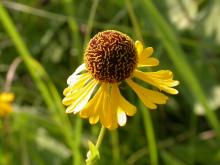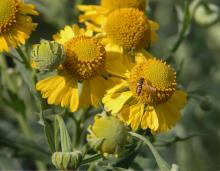Wildflowers, Grasses and Other Nonwoody Plants
Media

Species Types
Scientific Name
Anemone canadensis
Description
White anemone is a showy native wildflower with interesting, deeply toothed leaves. Often occurring in colonies, it spreads easily (even aggressively) from rhizomes and is sometimes cultivated in wildflower gardens.
Media

Species Types
Scientific Name
Ranunculus hispidus
Description
Hispid buttercup is a densely hairy plant with showy yellow flowers. It is found mostly in the southern half of Missouri, usually in moist locations.
Media

Species Types
Scientific Name
Potentilla simplex
Description
Common cinquefoil, or five-finger, is named for its leaves, which are divided into five fingerlike leaflets. One of seven cinquefoils in Missouri, it blooms from April to June and is scattered nearly statewide.
Media

Species Types
Scientific Name
Silene stellata
Description
A member of the pink or carnation family, starry campion has fringed, white petals that give it a starry appearance. It blooms from June to September in dry, wooded uplands and slopes.
Media

Species Types
Scientific Name
Galium aparine
Description
The tiny white flowers of this native plant are not very memorable, but the curious, sticky-feeling whorls of narrow leaves and lightweight, 4-sided stems make cleavers unique. And then there’s the tiny, round, “Velcro” covered balls of the seeds, which “stick tight” to your socks!
Media

Species Types
Scientific Name
Krigia biflora
Description
There are several members of the aster family that look something like common dandelions. But unlike the familiar lawn weed, two-flowered Cynthia is a native Missouri wildflower.
Media

Species Types
Scientific Name
Helenium flexuosum
Description
The purplish or brownish disk florets of purple-headed sneezeweed set it apart from our other sneezeweeds, whose centers are yellow. Look for it in moist, open areas, mostly in the southern half of the state.
Media

Species Types
Scientific Name
Lysimachia lanceolata
Description
You can find small colonies of lance-leaved loosestrife nearly throughout the state. It has showy but nodding yellow flowers and opposite, closely spaced, lanceolate or ovate leaves.
Media

Species Types
Scientific Name
Helenium autumnale
Description
Autumn sneezeweed is a late-blooming perennial with conspicuously winged stems. The flowerheads have yellow, domed disks. The ray flowers are fan-shaped, yellow, and notched.
Media

Species Types
Scientific Name
Symphyotrichum pilosum (formerly Aster pilosus)
Description
White heath aster is one of Missouri's most widespread and weedy native asters. It grows in uplands, bottomlands, and nearly all habitats in between. It has a shrubby, wide-branching habit, and the stem leaves are thin and needlelike.
See Also
About Wildflowers, Grasses and Other Nonwoody Plants in Missouri
A very simple way of thinking about the green world is to divide the vascular plants into two groups: woody and nonwoody (or herbaceous). But this is an artificial division; many plant families include some species that are woody and some that are not. The diversity of nonwoody vascular plants is staggering! Think of all the ferns, grasses, sedges, lilies, peas, sunflowers, nightshades, milkweeds, mustards, mints, and mallows — weeds and wildflowers — and many more!





















